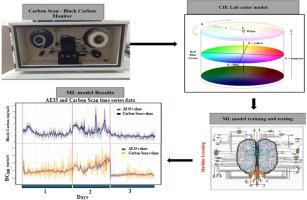Development and optimization of the low-cost optical monitor for real-time monitoring of atmospheric black carbon
Q2 Environmental Science
引用次数: 0
Abstract
Black Carbon (BC) is a major component of atmospheric aerosol produced from incomplete combustion of fossil fuels, biomass, and solid fuel. About 42 % of BC emissions are from open biomass burning with major contributions from Africa and Asia. A low-cost (<1500 US$) monitoring system is designed for large scale monitoring atmospheric BC near the surface for effective mitigation actions. Carbon Scan includes an air sampler with filtration of particulate matter of size 2.5 micron or less, a color sensor that captures image, and a machine learning (ML) model that retrieves BC concentration. Gradient Boosting Regressor (GBR) and Neural Network (NN) were trained and evaluated for the retrieval of atmospheric BC and its fraction from biomass burning. Carbon scan is a significant advancement in atmospheric BC monitoring. It achieves great accuracy, with a low RMSE of 1 µg/m³, Mean Absolute Error (MAE) of 0.40 µg/m³, Mean Absolute Percentage Error (MAPE) of 6.76 %, (SMAPE) of 5.84 % and a high R² of 0.97. The sensor provides an opportunity to monitor real time concentrations of atmospheric BC. Carbon scan is a low power, low cost, that ensures continuous air monitoring in remote areas, while capturing large temporal and spatial variations of BC.

低成本大气黑碳实时监测光学监测仪的研制与优化
黑碳(BC)是由化石燃料、生物质和固体燃料的不完全燃烧产生的大气气溶胶的主要成分。约42%的碳排放来自露天生物质燃烧,主要来自非洲和亚洲。设计了一个低成本(1500美元)的监测系统,用于大规模监测地表附近的大气BC,以便采取有效的减缓行动。碳扫描包括一个过滤尺寸为2.5微米或更小的颗粒物的空气采样器,一个捕获图像的颜色传感器,以及一个检索BC浓度的机器学习(ML)模型。对梯度增强回归器(GBR)和神经网络(NN)进行了训练和评估,以检索生物质燃烧产生的大气BC及其组分。碳扫描是大气BC监测的重要进展。它具有很高的精度,RMSE低至1 μ g/m³,平均绝对误差(MAE)为0.40 μ g/m³,平均绝对百分比误差(MAPE)为6.76%,(SMAPE)为5.84%,R²高至0.97。该传感器提供了实时监测大气BC浓度的机会。碳扫描是一种低功耗、低成本的技术,可确保在偏远地区进行连续的空气监测,同时捕捉到BC的大时空变化。
本文章由计算机程序翻译,如有差异,请以英文原文为准。
求助全文
约1分钟内获得全文
求助全文
来源期刊

Environmental Advances
Environmental Science-Environmental Science (miscellaneous)
CiteScore
7.30
自引率
0.00%
发文量
165
审稿时长
12 weeks
期刊介绍:
 求助内容:
求助内容: 应助结果提醒方式:
应助结果提醒方式:


